Human Flower Project
Monday, July 09, 2007
The Snake Pagoda
In Paleik, Myanmar, three reptile interlopers receive morning baths and fresh flowers in a Buddhist temple.
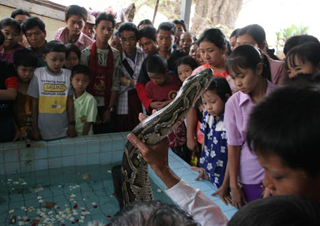
Morning rite at the Snake Pagoda, Myanmar
Photo: Travel Adventures
Min ga la baa.
With joy we welcome our first visitor from Myanmar! And for this occasion, we at last may post a floral treasure we’ve been holding back, images from a temple in Paleik. They come from a Buddhist sacred site called Yadana Labamuni Hsu-taungpye Paya—better known as Hmwe Paya, the Snake Pagoda.
Here, sometime in the 1970s, a caretaker who’d been clearing brush around the temple noticed that two pythons had curled up next to an image of the Buddha. They were soon joined by a third snake. For decades now, all three have been respectfully fed as part of daily religious observances here, and, to our amazement, the pool where the pythons swim is kept beautiful and scented with fresh blossoms.
The website where we found these pictures includes a fine narration, too.
“As I took off my shoes and walked into the pagoda, I did not notice anything special… There were donation boxes, people sitting on the floor to pray, kids running around, and of course the necessary amount of Buddha and other statues. But when I then approached the main Buddha image and walked past a small crowd, I saw them lying curled up next to the Buddha. Two giant pythons, resting and seemingly lazy, with money on their skin. You could stroke them, and hear them breathe.”
Ah, what must THAT sound like?!

Pythons of Hmwe Paya, the Snake Pagoda
Paleik, Myanmar
Photo: Travel Adventures
“Around 11am, the snakes are taken out to be washed in a special pool, watched by a pious crowd. They are then dried up, with towels and money, and fed some milk, after which they glide back to their statue. They are truly revered as if they were sacred animals, and taken care of very well. While watching the spectacle, I was amazed at the friendliness of the pythons and the respect with which they were treated.”
There seems to be some disagreement as to whether Buddhists should abstain from meat eating. And the pythons? Initially, each was fed “a pot of milk and three eggs every five days. But later on, due to instructions from a veterinarian, each was given 50 ticals of goat meat for protein.” It seems to us that the pythons’ dietary practice is entirely in keeping with Buddha’s reliance upon almsfood. They’re not hunting, just swallowing what’s offered.
Apparently, the Snake Pagoda is only 15 miles from Mandalay, in central Myanmar. This sounds well worth a trip, especially if one can manage to arrive in time for morning ablutions.
We’ve been coiled up ourselves, waiting for someone to venture forth to Human Flower Project from Myanmar, since many visitors have graced us from neighboring Thailand, China, and Bangladesh—and a few from Laos, also—for several years. We’ve heard that Internet access is heavily censored in Myanmar but that cyber cafes inside the country have managed wire-arounds. A recent story out of China reports that things may be changing. CCTV reports that a cyber city is being built in Mandalay. Also, “according to the telecommunications authorities, the number of internet users in Myanmar has reached nearly 300,000, up from merely 12 four years ago.”
Whoever you are, we’re so glad that you made it! We hope to learn much more about Myanmar, its websurfers, pythons and flowers in the months to come.
Sunday, July 08, 2007
Karl Marx & Blooms(bury)
Modernists, Marxists and skateboaders take to the public spaces of Bloomsbury. Thank you, John, for keeping our eyes on the sky.
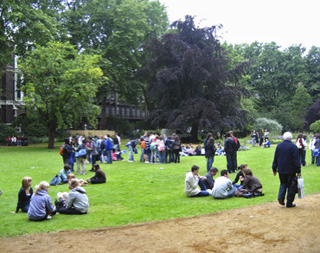
Gordon Square in Bloomsbury, Summer 2007
Photos: John Levett
By .(JavaScript must be enabled to view this email address)
…and Woolf, Strachey, Keynes, Forster & the rest of that bourgeois gang. But I’m getting carried away. So I’ll start at the beginning.
It’s the first week in July and the Socialist Workers’ Party organizes ‘a festival of resistance’ (it says here!) otherwise known as Marxism 2007 replacing the now-old-fashioned Marxism 2006 (‘Sooooo yesterday dahhhling!)—five days of meetings, discussions, seminars, rallies, gigs, screenings, forums in preparation for the next coming of the revolution (You do know it’s coming, don’t you? Watch the sky. Keep watching the sky!).
In the past I’ve had little time for the SWP, some of whose members await the Second Coming of Josef Stalin and others who can’t bear the thought of not being in the vanguard of anything resembling a march so spend loose time getting bus queues into a semblance of order.
But…they can put on a spiffing festival of radical bashing of capitalism & all its works. And that’s not all—there’s a lot of light (!) relief. Here’s a selection of meetings—1977 when Babylon burned: punk, politics & resistance; The case for a global pension & youth grant; Charlie Chaplin-a rebel in tramp’s clothes; The history of rebel art from Dada to Banksy; Duke Ellington; Katrina to Obama: Black leadership in the post-civil rights era; Mental Health, Inequality & the ‘Science of Happiness.’
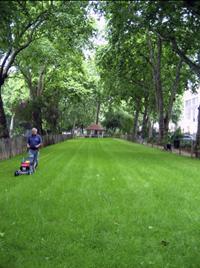 A wet summer in Woburn Square
A wet summer in Woburn Square
For those who need a daily confrontation, choose from the following—Communists in the Deep South; Palestine-the case for a one-state solution; Marx’s method in Das Kapital; Alienation & Liberation; What is the dialectic?; Rosa Luxembourg & the mass strike; The uses & abuses of Gramsci. And so it goes, over one hundred and eighty meetings in five days & if you can’t get to all (which you won’t, there are up to ten meetings an hour) there are CDs of the ones you missed available within minutes of the speaker’s last breath. In between yours (breaths, that is) there’s a half-hour coffee & sarnie & carry-on-the-debate break. And it all takes place in Bloomsbury.
Bloomsbury was described in the 1086 Domesday Book (William the First’s attempt to catalogue the wealth of the nation he’d just invaded) as having vineyards & woods for a hundred pigs, since when it has grown. It’s bounded on the north by Marylebone Road & to the west by Tottenham Court Road & houses a sizeable part of the University of London & its associated colleges. But school’s out & the Marx bash takes over.
I studied briefly at the London School of Economics in the ‘60s but spent most of my time sitting in one or another of Bloomsbury’s squares. The same thing came to pass a few years later as I was doing research in the British Library when it was housed in the British Museum—read some, find a park. Marx, it seems, kept his head down researching there for Capital but the squares would have been locked against the invasions of skint German immigrants; they’ve long since been made public.
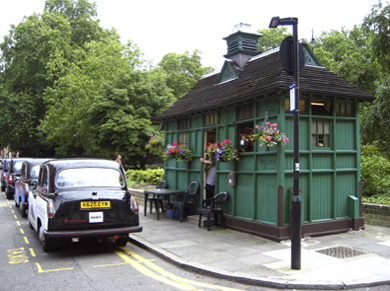
Russell Square
The area of Bloomsbury was owned by the Dukes of Bedford (otherwise known as the Russell family, variously admirals, generals, prime ministers, chinless wonders & a fine philosopher) & this ownership resulted in the beneficial planning & laying-out of houses & gardens giving a continuity & (as far as London allows) a tranquility rare in the neighbourhood of King’s Cross & St. Pancras stations.
Some squares have gained a wider recognition in the wake of the 7/7 bombings—Russell Square & its tube bomb, Tavistock Square & its bus bomb. Ironically, Tavistock is known as the ‘peace’ square with its statue of Gandhi & memorials to conscientious objectors & victims of Hiroshima. A national memorial to the 7th. July victims is to be unveiled in the square in July 2008.

Statue of Gandhi in Tavistock Square
London has never been a tranquil city. It’s anarchic, bad-tempered, dense, terminally knocked down & rebuilt, too many people in too many cars & too many tube trains; it needs its squares, even if they’re unmemorable.
Unless you have memories that is. For me, it’s an ambivalent relationship with the Bloomsburys; most notably Virginia Woolf & Lytton Strachey, & I used to be much exercised to understand why. It’s never been, only, a question of the quality of their writing. I first came to Strachey in 1967 when Michael Holroyd published the first volume of his life. I remember buying it as a Christmas present for myself & spending the whole of Christmas day wishing I was somewhere else & sometime else. I’d just finished reading Beatrice Webb’s My Apprenticeship & had started collecting biogs of George Bernard Shaw &, in the middle of the most dynamic decade of the century, found myself wishing back to the last decade of the last. It’s never gone away.
I was travelling down to London last week & met a friend on the train. We got to talking about books & authors & why I read Virginia Woolf more than any other & kept returning to her. It’s about modernism or, more precisely, Modernism. Capitalising it makes it more specific, more about dynamic change, recognising the moribund state of an idea, an ideal, a convention, a system, a way of living, a way of survival & seeking change. It’s about liberation of feelings, of accepted modes of behaving, a refusal to accept the accepted, of responding to a new mode of living, new requirements of life; looking at a society at the end of its current episode & wanting to cut its legs off & its head too. The Great War did for it & Woolf revealed its hypocrisy in ways untried. I think she was a brave writer (as far as writers can be brave in a liberal society); modern in a way that modern no longer is. Modern then was striving, failing, recovering & recommitting, facing up & being willing to fail, knowing that to try is to succeed. Modern now?
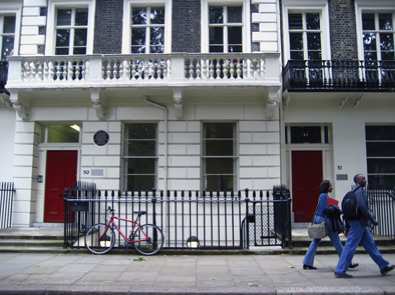
51 Gordon Square, residence of Lytton Strachey 1909-1924
Which brings me back to the square I’m in—Gordon Square. The Stephen family (Virginia’s) moved to number 46 upon the death of her father. John Maynard Keynes lived at the same address from 1917 onwards while Lytton Strachey lived at number 51 from 1909 to 1924. Looking at the Square now it’s nothing special—lunch space for local academics, office workers, Brazilian teenagers with phone cameras, German parents with all the paraphernalia (great word!) that seems essential for parenting these days. And the odd Marxist. I often just pass the Square on the opposite pavements, give a nod to the relevant house & pass on. No time, nor inclination, to entering into imaginings.
The Bloomsburys spread out but never far away—Brunswich Square, Tavistock, Fitzroy, Bedford & then Mecklenburgh until the Woolfs were bombed out in 1940. Enter a new modernism. But the Squares stayed.
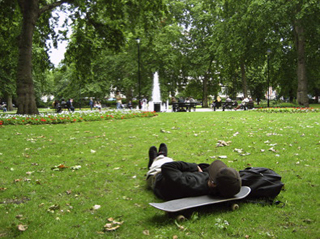 Mover at rest
Mover at rest
in Russell Square
They’ve become what people want to make of them—some give themselves over to noise, some to quiet reading; picnics fit some of them, study suits others. None are noted for their blooms—they’re too much used as thoroughfares—but they fit this part of the city, their buildings & their associations. Woolf, Keynes & Strachey (less) changed the way we view how we live & who we are but the hangers-on were parochial & dominated English arts & letters longer than they deserved to. Most who use the squares these days know nothing of their associations & many could care less. Moving on’s good for us all.
It’s midsummer in the wettest summer since records began. Some cities suit the rain—Paris looks good in anything, London doesn’t. It’s started to spit. Back to work—sometimes Marxism feels like that.
Art & Media • Culture & Society • Gardening & Landscape • Permalink
Friday, July 06, 2007
Footwear for an Urban Fairy
Designer Michel Tcherevkoff goes to town with flowers, cobbling them into fantasy shoes.

Comes with matching handbag
Shoe Fleur, by Michel Tcherevkoff
Opinion: We don’t think fairies wear shoes.
For one thing, they tend to live off where it’s mossy, in shady groves, sleepy hollows and the like. Not a lot of pavement in Neverneverland. And even if there were, fairies fly, so why would they trouble with footwear?
Michel Tcherevkoff doesn’t appear to have thought this though, and so—bless his kinky heart—has created Shoe Fleur, a line of espadrilles, heels, and lacey sandals all floral. Many thanks to imp and friend Carolyn Courtney for alerting us.
 “Feet to be Tied” by Michel Tcherevkoff
“Feet to be Tied” by Michel Tcherevkoff
From Shoe Fleur
Each shoe is composed of the leaves and blossoms on one plant (fantasy needs some parameters). Moonwalk, a platform shoe, has a thick sole that looks cushy, made from a pile of tropical greens. Cocktail Teaser is foot lingerie—orchids, of course. For a toga party, there’s Via Appia, with thongs aplenty, but don’t pull those little stems and strands too tight or the daisies will pop all over your calf. (Perhaps that’s the whole point, Gargantua.) We especially like how Tcherevkoff thought to use crimson coxcomb, velvety enough for the Dr. Scholl’s set.
We suppose these shoes are for urban fairies, who wouldn’t be caught dead going barefoot. Those city flitters who get stuck in aerial traffic will come occasionally down to Earth.
Wednesday, July 04, 2007
Growing Old Glory
We salute floral flags this Independence Day. Happy 4th of July!
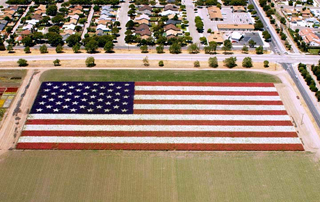
Lompoc, California
Photo: Bill Morson
Have a spare six acres and 400,000 larkspurs? You just might try reproducing Bodger Seeds’ highly successful display of gardening patriotism. The flag, grown in 2002, was 740 ft. X 390 ft., with each star 24 feet in diameter. No wonder Betsy Ross opted for needle and thread rather than shovel and hoe.
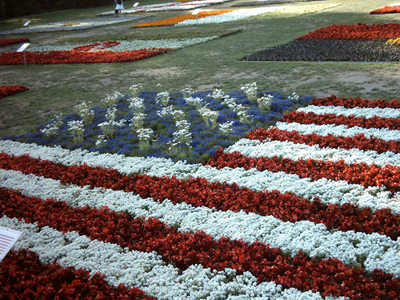
Gelsenkirchen, Germany.
Photo: Chajm
The stars and stripes grew among floral flags of other nations mass planted at the 2006 World Cup competition last summer in Germany.
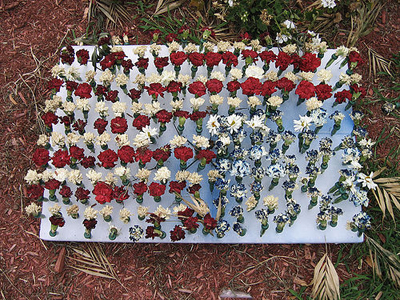
In Memoriam
Photo: Heap
A flag quietly fades on a veteran’s grave.
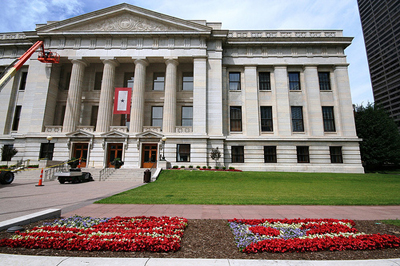
Columbus, Ohio
Photo: Oz in Ohio
U.S. and Ohio flags grow side by side before the Ohio State House. (We thought only the Texas flag was permitted to “fly” at the same height as Old Glory?)
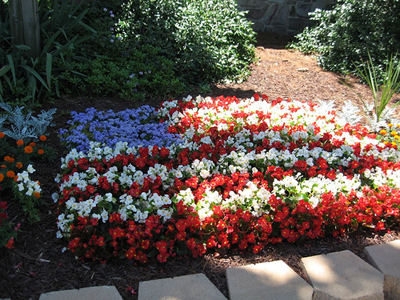
Somewhere in Pennsylvania
Photo: Talia Shire
Red and white begonias do well for stripes. We’re not sure what flower supplies the blue bed of stars here. Gardeners?
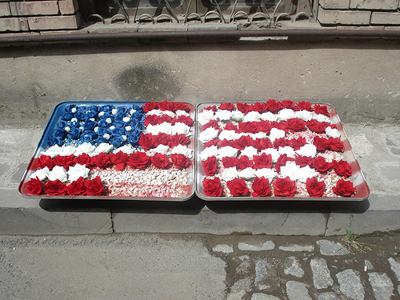
On the sidewalk, T’blisi, Georgia
Photo (and flag?): Michiexile
Our favorite floral flag comes from a street art exhibition in Georgia (the country, not the US state). Flags from Estonia, Russia, Switzerland, Israel and many other nations—including the U.S.A.—were arranged in metal trays and set out by the curb, where they bear an appealing resemblance to cupcakes. Yes, it’s July 4th, but think internationally and make sure to see the whole yummy set. Thanks to Michiexile for sharing these on flickr.
Now, please stand and proudly sing.




